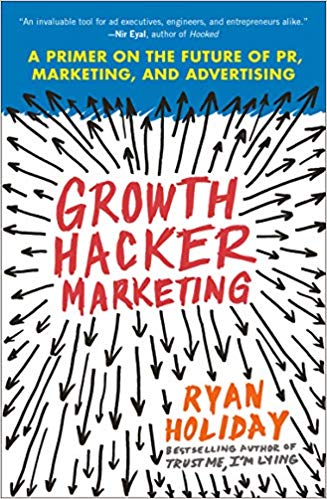
Marketing bookshelf
Growth Hacker Marketing
By Sarah Zane
It was a day that started like any other. Ryan Holiday was plowing through his routine, unaware that his life was about to take a hairpin turn. And then he saw the headline that would change everything: “Growth Hacker Is the New VP [of] Marketing.” The article beneath the headline alleged that a new job title of “growth hacker” was poised to replace all VPs of marketing in just a few years’ time.
As a self-taught, wildly successful and super-young VP of marketing himself, Ryan found the premise of the article disturbing — and intriguing. He could not help wondering, what are growth hackers, and how will they ultimately replace him and his colleagues?
Instead of trying to fight it, Ryan changed course, setting out to learn all he could about growth hacking. And along the way, he became a superstar growth hacker whose expertise is now sought by some of the most successful companies and authors today.
In Growth Hacker Marketing, Holiday shares his journey and the knowledge he’s picked up along the way with marketers around the world.
Here are the three primary lessons inside Growth Hacker Marketing:
Lesson 1: Marketing has completely changed over the last few decades.
The concepts and theories that drove the marketing world since its inception are no longer true. Once upon a time, it was enough to offer a fantastic product and market it to as many people as possible. Today’s startups must focus on growth hacking over old-fashioned marketing to be heard through all the noise.
Growth hacking is a technology-based approach where marketing mechanisms are built into a company’s initial product. To growth-hack their way to greatness, startups will focus on getting this first product out as quickly as possible, even if it’s flawed. They’ll measure and track every bit of data on the product’s success, and then use that information to launch a new and improved version two.
You can incorporate this lesson in your own credit union whenever you launch a new product or feature. Don’t overthink the initial launch. Instead, get your first version out there as quickly as you can and track its success as closely as possible. When you launch your second version, fix all the failures of your initial product and make it something your members will absolutely adore.
Lesson 2: Target a small, specific customer base.
Don’t try to sell to everybody. It only leads to fewer sales, and more sales to the wrong customers. As Ryan writes, selling lawn mowers to apartment dwellers might sound impressive, but these customers can’t help you improve your product in any way. Instead, it’s best to target a small and very specific group of people who are a perfect fit for your product.
Bring this lesson home: When trying to grow your credit union membership, don’t try to attract everybody within your field of membership. Instead, focus on one demographic who would benefit most from being a member of your credit union. Reach them through targeted marketing that speaks their language and highlights how you can meet their financial needs.
Lesson 3: Let your product go viral by letting customers market for you.
How do you get your product to go viral? According to Ryan, it’s remarkably simple: Make it shareable and tell your customers to share it with friends.
In practical terms, this means incentivizing and simplifying a referral program so your members turn into your best marketers.
Growth hacking is an entirely new approach to traditional marketing with the same end goal: to help your organization achieve maximum reach. Using the ideas and tips outlined in Growth Hacker Marketing, you, too, can achieve the ultimate in marketing success.


